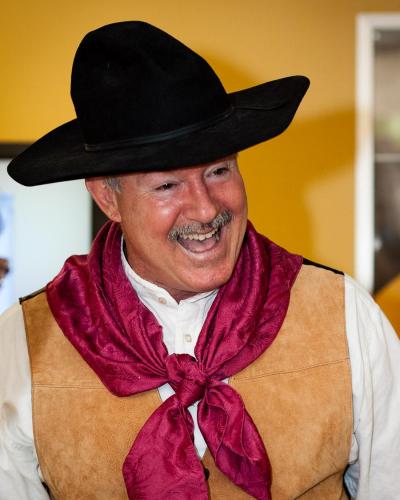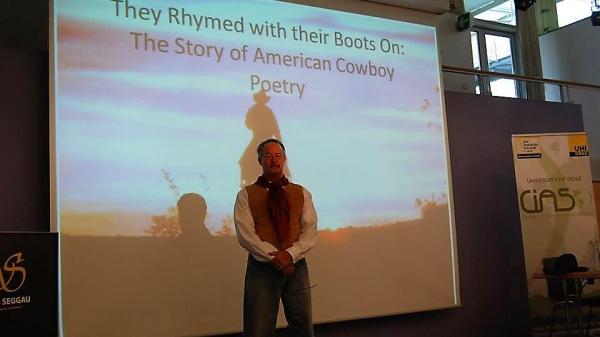What is the "real West," as cowboy poet Paul Zarzyski asks, "the sunset into which – / imagine why, if you will – the cowboy rides off"?
And what, for that matter, is cowboy poetry?
“Cowboy poetry or ranch poetry is a genre born out of the big American cattle drives between 1865 (end of the Civil War) and 1874 (barbed wire patent),” explained James Blasingame, ASU English professor and expert performer of the folk art. “It existed in relative obscurity until Baxter Black appeared on Johnny Carson in 1987 and performed some of his humorous poems.”
Blasingame first became interested in cowboy poetry when completing an alternative research project on the topic for his PhD program at the University of Kansas. He realized that Kansas was an end point to many nineteenth-century cattle drives; he had also recently seen Baxter Black in a series of television episodes for Iowa Public Television. Black, a large animal veterinarian and public radio star who lives near Benson, Arizona, quickly became Blasingame's favorite cowboy poet. “I set out around the country, following the cattle drive routes backwards, interviewing people along the way, and doing a week of research at the Archives of the Big Bend in Alpine, Texas,” said Blasingame.
Nowadays, Blasingame also enjoys following modern poet Paul Zarzyski, a rodeo competitor with an MFA in poetry from the University of Montana. And Blasingame has transformed from a student of the form to an artist; he is a frequent cowboy poetry performer at academic conferences and social gatherings.
For Blasingame, the process for picking poems to perform is an in-depth process with many criteria: “[The poems I perform] do have to be steeped in a value system that emphasizes stewardship of the land, honest dealing with other people, and appreciation for the animals that provide (or provided) a life for human beings,” he explained.
Cowboy poetry is inherently an oral tradition; the original poems were composed and then memorized by drovers herding cattle along the now famous trails. “Their lives were composed of hundreds of hours of boredom punctuated with moments of extreme danger," said Blasingame. "They entertained themselves by making up lyrics for songs based on the meter and rhyme of the only songs they knew (old folk ballads or hymns), usually in iambic quadrameter that may have been the unconscious result of living every day, all day, with the rhythm of hoof-beats on the trail.”
Over the years, some of the songs have survived, though most have lost their musical melodies and exist now only as poems. Blasingame told the story of one collection's serendipitous survival: “In 1895, an early ethnomusicologist named John Lomax, an undergraduate at the University of Texas first presented his collection of the poems and songs he had heard as a boy." Lomax was from a Texas ranch family and many of the songs he knew "came from formerly enslaved men—almost all Texas cattle drives included African American cowboys, as well as Mexican and Native American cowboys,” Blasingame explained. Lomax's English professor at the University of Texas deemed these songs and poems that Lomax collected "worthless," stating they had no cultural value whatsoever. However in 1906, when Lomax moved to Harvard, he was given quite different information by two scholars there: the collection was utterly valuable for its historical as well as its artistic significance. Many of Lomax's recordings of songs from his collection are still available in the Library of Congress.
One of Blasingame’s favorite aspects of performing is meeting people from other parts of the world—people who have held life-long fascination for the iconic American cowboy. The InSTEP Program of 65 educators from India who visited ASU, and the participants in the International Institute on Inter-American Studies at Saggau Castle in Austria are among these fans who, according to Blasingame, said they had "seen every western movie ever to come out of America."
Blasingame’s favorite performance so far was with the InSTEP educators from India. He not only had an opportunity to explain how the cattle drives helped create the cultural phenomenon of the American cowboy, but he also danced with his wife, Lori. “My wife, a ballroom dance instructor, helped out with a western swing dance, and my stepson, George, played the guitar for a cowboy song," he said.
Although Blasingame has distant relatives who are famous cowboys, he clarified that he is not a cowboy himself. “I cannot write genuine cowboy poetry. I can, however, study the genre and how it came to be and continues.” Blasingame also explained that scholars of cowboy poetry, such as James Hoy at Emporia State University and Barbara Nelson at Sul Ross State University, argue that authentic cowboy poetry is not trite or silly. Rather, it celebrates a lifestyle and its values.
A genre theorist Amy Devitt, who was also one of Blasingame’s professors at the University of Kansas, explained that genre is not so much about form as it is about a language product entailing shared experiences and understandings among members of a group. Blasingame continued, “It both defines the group’s values and excludes nonmembers, who find it hard to understand the meaning of a poem.”
Blasingame’s next cowboy poetry event is performing for the International Leaders in Education Program (ILEP). “The US Department of State has 16 high school teachers from India, Bangladesh, the Philippines, Malaysia, Indonesia, Brazil, Kenya, Ghana, and Senegal spending a semester at ASU to work on collaborative projects with us,” he said. During this time, the participants will be preparing professional development to take back to their home countries. This will also give them an opportunity to share their own best teaching techniques with ASU and the Phoenix Union High School district.
To also enjoy a few days listening to some amazing cowboy poets perform, Blasingame highly suggested that everyone attend the Cowboy Poetry Gathering in Prescott, Arizona on August 9, 10, and 11, 2018.
Image 1: Jim Blasingame has performed cowboy poetry for ASU's Night of the Open Door events several times, as he does in this 2013 photo by Bruce Matsunaga.
Image 2: Cowboy poetry is both scholarship and art for Blasingame, as he has given conference presentations and written articles on the genre as well as performed it. Photo is courtesy Blasingame.
Video: James Blasingame contributed this classroom video of his and wife Lori Ross's performance of a western dance for the InSTEP program.

